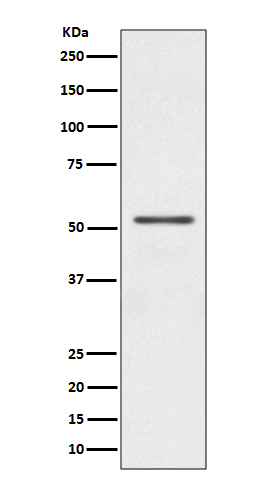Functions within a multiprotein E3 ubiquitin ligase complex, catalyzing the covalent attachment of ubiquitin moieties onto substrate proteins (PubMed:
10888878, PubMed:
10973942, PubMed:
11431533, PubMed:
12150907, PubMed:
12628165, PubMed:
15105460, PubMed:
16135753, PubMed:
21376232, PubMed:
21532592, PubMed:
23754282, PubMed:
23620051, PubMed:
24660806, PubMed:
24751536, PubMed:
32047033, PubMed:
29311685, PubMed:
22396657). Substrates include SYT11 and VDAC1 (PubMed:
32047033, PubMed:
29311685). Other substrates are BCL2, CCNE1, GPR37, RHOT1/MIRO1, MFN1, MFN2, STUB1, SNCAIP, SEPTIN5, TOMM20, USP30, ZNF746, MIRO1 and AIMP2 (PubMed:
10888878, PubMed:
10973942, PubMed:
11431533, PubMed:
12150907, PubMed:
12628165, PubMed:
15105460, PubMed:
16135753, PubMed:
21376232, PubMed:
21532592, PubMed:
23754282, PubMed:
23620051, PubMed:
24660806, PubMed:
24751536, PubMed:
22396657). Mediates monoubiquitination as well as 'Lys-6', 'Lys-11', 'Lys-48'-linked and 'Lys-63'-linked polyubiquitination of substrates depending on the context (PubMed:
19229105, PubMed:
20889974, PubMed:
25621951, PubMed:
32047033, PubMed:
25474007). Participates in the removal and/or detoxification of abnormally folded or damaged protein by mediating 'Lys-63'-linked polyubiquitination of misfolded proteins such as PARK7: 'Lys-63'-linked polyubiquitinated misfolded proteins are then recognized by HDAC6, leading to their recruitment to aggresomes, followed by degradation (PubMed:
17846173, PubMed:
19229105). Mediates 'Lys-63'-linked polyubiquitination of a 22 kDa O-linked glycosylated isoform of SNCAIP, possibly playing a role in Lewy-body formation (PubMed:
11431533, PubMed:
11590439, PubMed:
15105460, PubMed:
19229105, PubMed:
15728840). Mediates monoubiquitination of BCL2, thereby acting as a positive regulator of autophagy (PubMed:
20889974). Protects against mitochondrial dysfunction during cellular stress, by acting downstream of PINK1 to coordinate mitochondrial quality control mechanisms that remove and replace dysfunctional mitochondrial components (PubMed:
32047033, PubMed:
19029340, PubMed:
19966284, PubMed:
23620051, PubMed:
24896179, PubMed:
25527291, PubMed:
18957282, PubMed:
21376232, PubMed:
22396657, PubMed:
24660806, PubMed:
25474007, PubMed:
24784582, PubMed:
11439185, PubMed:
22082830, PubMed:
23933751). Depending on the severity of mitochondrial damage and/or dysfunction, activity ranges from preventing apoptosis and stimulating mitochondrial biogenesis to regulating mitochondrial dynamics and eliminating severely damaged mitochondria via mitophagy (PubMed:
32047033, PubMed:
19029340, PubMed:
19801972, PubMed:
19966284, PubMed:
23620051, PubMed:
24896179, PubMed:
25527291, PubMed:
21376232, PubMed:
22396657, PubMed:
11439185, PubMed:
22082830, PubMed:
23933751, PubMed:
33499712). Activation and recruitment onto the outer membrane of damaged/dysfunctional mitochondria (OMM) requires PINK1-mediated phosphorylation of both PRKN and ubiquitin (PubMed:
24660806, PubMed:
25474007, PubMed:
24784582, PubMed:
25527291). After mitochondrial damage, functions with PINK1 to mediate the decision between mitophagy or preventing apoptosis by inducing either the poly- or monoubiquitination of VDAC1, respectively; polyubiquitination of VDAC1 promotes mitophagy, while monoubiquitination of VDAC1 decreases mitochondrial calcium influx which ultimately inhibits apoptosis (PubMed:
32047033). When cellular stress results in irreversible mitochondrial damage, promotes the autophagic degradation of dysfunctional depolarized mitochondria (mitophagy) by promoting the ubiquitination of mitochondrial proteins such as TOMM20, RHOT1/MIRO1, MFN1 and USP30 (PubMed:
19029340, PubMed:
19966284, PubMed:
21753002, PubMed:
23620051, PubMed:
24896179, PubMed:
25527291, PubMed:
22396657, PubMed:
23933751). Preferentially assembles 'Lys-6'-, 'Lys-11'- and 'Lys-63'-linked polyubiquitin chains, leading to mitophagy (PubMed:
25621951, PubMed:
32047033). The PINK1-PRKN pathway also promotes fission of damaged mitochondria by PINK1-mediated phosphorylation which promotes the PRKN-dependent degradation of mitochondrial proteins involved in fission such as MFN2 (PubMed:
23620051). This prevents the refusion of unhealthy mitochondria with the mitochondrial network or initiates mitochondrial fragmentation facilitating their later engulfment by autophagosomes (PubMed:
23620051). Regulates motility of damaged mitochondria via the ubiquitination and subsequent degradation of MIRO1 and MIRO2; in motor neurons, this likely inhibits mitochondrial intracellular anterograde transport along the axons which probably increases the chance of the mitochondria undergoing mitophagy in the soma (PubMed:
22396657). Involved in mitochondrial biogenesis via the 'Lys-48'-linked polyubiquitination of transcriptional repressor ZNF746/PARIS which leads to its subsequent proteasomal degradation and allows activation of the transcription factor PPARGC1A (PubMed:
21376232). Limits the production of reactive oxygen species (ROS) (PubMed:
18541373). Regulates cyclin-E during neuronal apoptosis (PubMed:
12628165). In collaboration with CHPF isoform 2, may enhance cell viability and protect cells from oxidative stress (PubMed:
22082830). Independently of its ubiquitin ligase activity, protects from apoptosis by the transcriptional repression of p53/TP53 (PubMed:
19801972). May protect neurons against alpha synuclein toxicity, proteasomal dysfunction, GPR37 accumulation, and kainate-induced excitotoxicity (PubMed:
11439185). May play a role in controlling neurotransmitter trafficking at the presynaptic terminal and in calcium-dependent exocytosis. May represent a tumor suppressor gene (PubMed:
12719539).

